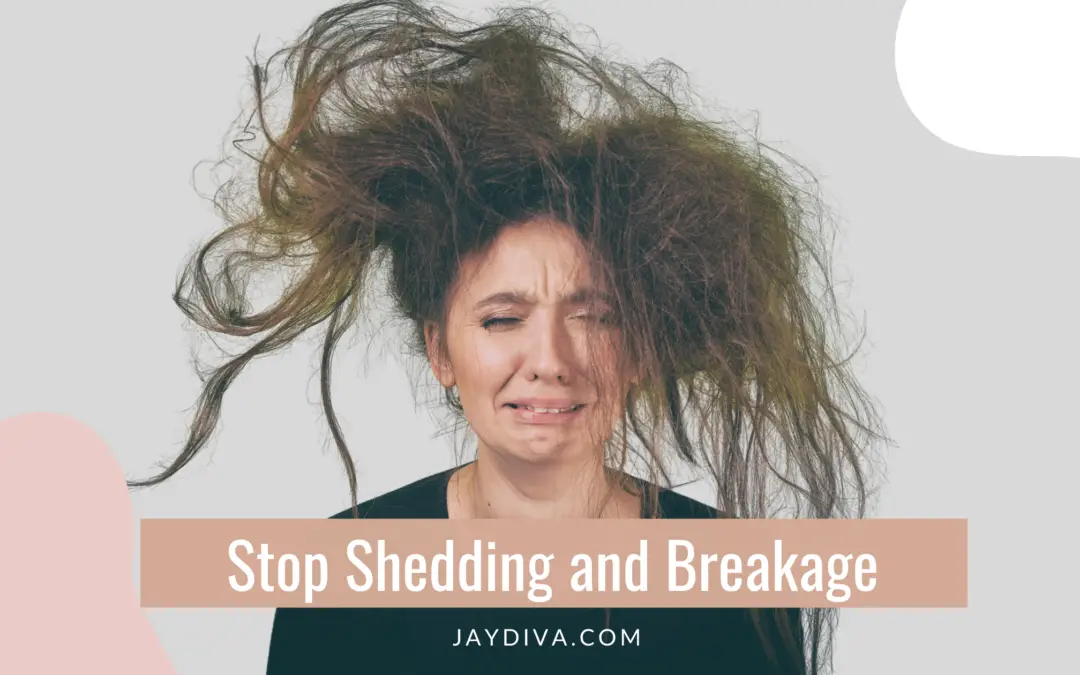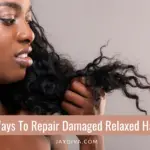Are you dealing with excessive shedding and breakage on your relaxed hair? If so, you’re not alone. These are two common issues that many women experience when transitioning to or wearing a relaxer. Fortunately, there are steps that you can take to reduce the amount of Shedding and breakage on relaxed hair.
In this blog post, we’ll discuss some of the causes of Shedding and breakage and share tips for how to prevent them. We’ll also highlight some of our favorite products for keeping your relaxed hair healthy and happy. So keep reading to learn more!
Our hair naturally goes through a phase of shedding in order to make way for new growth. This is a completely normal process that takes place slowly over time.
Typically we shed about 100 hairs a day, but what gets us worried is when we begin to shed excessively. certain conditions can cause this process to occur at a much faster rate, such as when our hair is lacking nutrients.
Conveniently, our hair’s nutrient needs can be met with a healthy diet and supplementation.
Other conditions that can cause excessive shedding is during pregnancy and menopause.
Breakage on the other hand is always a sign that you must take a closer look at your relaxed hair care routine.
With relaxed hair breakage, the hair falls out anywhere along the shaft of the hair while with shedding the hair comes out at the root.
- What are the causes of relaxed hair shedding and breakage?
- How do I Stop My Relaxed hair from shedding and breaking?
- #1 Use Mild Shampoos
- #2 Condition Regularly
- #3 Be Gentle when Handling your hair
- #4 Avoid Over-processing your hair
- #5 Stretch your relaxers correctly
- #6. Avoid Flat Irons
- #7 Trim Regularly
- #8 Use Protective Styling
- #9 Airdry More Often
- #10 Baby your ends
- #11 Avoid wearing tight braids or weaves
- #12 Make sure to eat a balanced meal
- Shedding and breakage on Relaxed Hair FAQs
- Final takeaway
Table of Contents
What are the causes of relaxed hair shedding and breakage?
There are many things that can cause shedding and breakage in relaxed hair. The most common causes are
- Dry brittle hair,
- Over manipulation,
- Over-processing of the hair, and
- Poor hair care practices.
How do I Stop My Relaxed hair from shedding and breaking?
Relaxed hair, in particular, is more prone to shedding and breakage and this is of course due to the damage incurred when the hair is relaxed.
The good news is that there are easy ways to stop relaxed hair shedding and breakage.
Let’s dive in:
#1 Use Mild Shampoos
It goes without saying that the smoother and silkier your hair feels, the easier it will be to stop shedding and breakage on your relaxed hair.
This means using a gentle cleanser regularly when washing your hair instead of say a clarifying shampoo which can strip away all of your hair’s natural moisture, leaving the follicle open for damage (or even worse…breakage).
Pick shampoos that are designed for dry or damaged hair, or opt for sulfate-free formulas. These shampoos cleanse the scalp without leaving your hair dry and stripped of its natural oils.
Sulfate-free shampoos top picks
Related Post:
15 Best sulfate-free shampoos for dry and frizzy hair
#2 Condition Regularly
Conditioners coat the hair shaft with moisture and strengthening ingredients, which adds flexibility to the cuticle layer and reduces breakage.
Regularly deep conditioning your hair will prevent breakage and keep your relaxed hair healthy.
Try to deep condition weekly and when you do so, be sure to alternate between a moisturizing deep conditioner and a protein deep conditioner to maintain the right moisture-protein balance. this ensures the hair is flexible and strong at the same time.
If your breakage is due to weakness from lacking protein, a deep protein treatment will offer a quick fix.
Deep conditioners for relaxed hair top picks
#3 Be Gentle when Handling your hair
When you are attempting to style relaxed hair it is important for you to remember that your hair is not as strong as it used to be before chemical treatment.
I always say that relaxed hair should be treated like fine silk. we should be careful when handling relaxed hair from the way we comb our hair (using a wide-tooth comb and begin detangling from the tips and work your way to the roots to minimize breakage) to the way we wash our hair: wash relaxed hair in sections to minimize tangling and cut down on your detangling time.
The way we treat our relaxed hair will be reflected in how it flourishes.
#4 Avoid Over-processing your hair
This is one of the most common causes of excessive breakage on relaxed hair. Many times relaxers are applied wrongly to the hair and this leaves the hair weak and lifeless. Relaxers should be applied only to the new growth and not to the previously relaxed areas. The relaxer processing time should also be within the recommended time for your hair type and density.
This leads on to the next point:
#5 Stretch your relaxers correctly
A key to avoiding over-processing your hair is to stretch your relaxers. This simply means going relaxer-free for a period to allow time for enough new growth before the next relaxer day. This ensures you have an ample amount of new growth when relaxing so the relaxers are not applied to already relaxed hair.
Many box relaxers recommend you go six weeks between relaxers, but with the average amount of hair we grow per month which is around 0.5inches, it will be difficult to avoid relaxer transfer to previously relaxed hair.
Aim to stretch anywhere from 8-12 weeks to allow for 1-1.5inches of new growth.
Now while stretching your relaxers can be a good thing, when it is done wrong you could experience a lot of breakage at the demarcation line( this is where the new growth meets the previously relaxed hair.
To avoid this you should know when it’s time to end your relaxer stretch and keep your hair adequately moisturized and deep conditioned during the stretch.
#6. Avoid Flat Irons
To minimize breakage and achieve healthy relaxed hair, flat irons need to be far from you. you want to straighten your hair as sparingly as you can.
Flat irons cause relaxed hair breakage by breaking the internal bonds of your hair which for relaxed hair is a NoNo because the relaxers have done enough damage already.
When you have to use one ensure your hair is adequately protectant with a heat protectant serum and you are not using the highest heat setting. A few passes too will do the trick rather than making several passes for the sleekest look.
#7 Trim Regularly
Shedding and breakage can be caused by many factors, but one thing you can do to minimize this problem is by getting a trim every 8-12 weeks. trimming relaxed hair is important because it helps to remove the breakage that is near your ends, which can help minimize breakage as it grows out. if the split ends are not taken off, they travel up the shaft and cause breakage and leave your hair looking straggly.
#8 Use Protective Styling
Another way that you can stop shedding and breakage is by protective styling. The ends of our hair are the oldest and driest parts of our hair and so should be treated like a fine fabric. Wear styles that keep your ends tucked away from your clothes as well are the harsh weather elements.
Low maintenance protective styles are buns, cornrows, braid extensions, weaves, and wigs.
#9 Airdry More Often
One of the best things you can do to stop shedding and breakage is to air-dry your hair more often. Although it may seem silly, laying off from using the blow dryer and flat iron will stop you from over-drying your hair and causing it to shed and break off.
When the heat is applied to your relaxed hair, it essentially “stresses” the follicles, and dries the hair very quickly rather than allowing the hair to retain moisture.
Learn to air dry with a silk scarf, for a smooth and shiny finish.
#10 Baby your ends
Another really important way to stop your relaxed hair from shedding and breaking off is to baby your ends because the ends of our hair are the oldest and driest parts of the hair and if left unattended to, can dry out, spit and break off.
Ensure that on a daily basis your ends are moisturized with a rich water-based moisturizer and then sealed with a lightweight oil to lock in that moisture.
Water-based moisturizers for relaxed hair top picks
#11 Avoid wearing tight braids or weaves
Braids and weaves are good protective styles but when they are done wrongly, can cause more harm than good.
Making the braids too tight and tiny, and leaving them in too long are sure-fire ways to damage our hair follicles, cause dryness and ultimately lead to breakage.
Medium-sized braids exert less tension on the scalp, and 2-3 weeks is a sweet spot to leave in your braids.
#12 Make sure to eat a balanced meal
Another thing you can do to stop shedding and breakage on relaxed hair is to make sure that your diet is balanced. when we are healthy it will reflect in our hair, skin, and nails.
Foods that promote healthy hair are eggs, whole grains, fish, beef and beans, etc.
Shedding and breakage on Relaxed Hair FAQs
Are shedding and breakage the same thing?
Shedding is when part or all of your hair falls out from the scalp while breakage is when the hair shaft breaks off for various reasons.
What causes shedding and breakage?
Excessive amounts of shampooing and brushing are some of the causes of shedding and breakage, wrong use of chemicals such as relaxers and color treatments also cause breakage. Additionally, heat styling can worsen the problem by making your hair dry and brittle leaving your hair breakage-prone.
What are some common signs that I may be experiencing shedding or breakage?
Signs of excessive shedding and breakage include shorter hairstyles than usual because more hair is falling out than growing in, tangles (especially near your hairline in the nape and around your ears). If you notice that a lot of your hair is coming out in clumps when you brush or comb it, then you may be experiencing excessive shedding or breakage.
Why is my hair falling out after a relaxer?
Relaxing your hair makes it more susceptible to breaking and shedding. Hair falls out and breaks during the course of its life, but relaxed hair is even more prone to breakage.
This is because relaxers straighten the hair by breaking disulfide bonds in the hair shaft, this compromises the health of the hair and causes breakage.
Final takeaway
The key to stopping relaxed hair breakage and excessive shedding is to incorporate health hair care practices that prevent dryness and stop those that leave your hair prone to dryness and breakage.
Check out these related posts:























